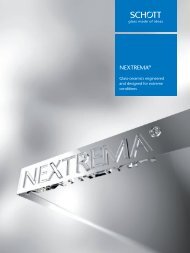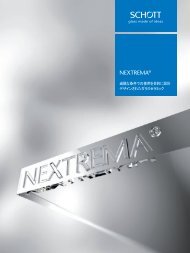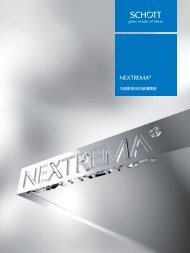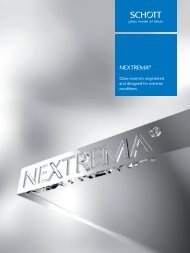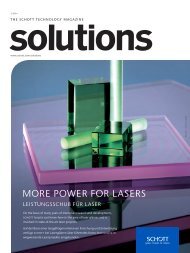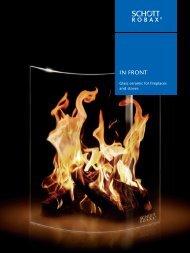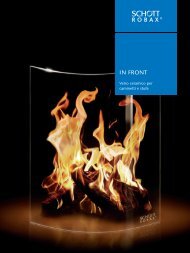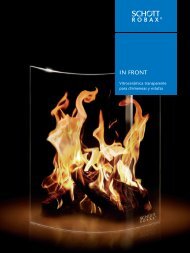SCHOTT Technical Glasses
Apart from its application in optics, glass as a technical material has exerted a formative influence on the development of important technological fields such as chemistry, pharmaceutics, automotive, optics, optoelectronics and information technology. SCHOTT Technical Glasses offers pertinent information in concise form. It contains general information for the determination and evaluation of important glass properties and also informs about specific chemical and physical characteristics and possible applications of the commercial technical glasses produced by SCHOTT. With this brochure, we hope to assist scientists, engineers, and designers in making the appropriate choice and make optimum use of SCHOTT products.
Apart from its application in optics, glass as a technical material has exerted a formative influence on the development of important technological fields such as chemistry, pharmaceutics, automotive, optics, optoelectronics and information technology. SCHOTT Technical Glasses offers pertinent information in concise form. It contains general information for the determination and evaluation of important glass properties and also informs about specific chemical and physical characteristics and possible applications of the commercial technical glasses produced by SCHOTT. With this brochure, we hope to assist scientists, engineers, and designers in making the appropriate choice and make optimum use of SCHOTT products.
Create successful ePaper yourself
Turn your PDF publications into a flip-book with our unique Google optimized e-Paper software.
20<br />
4. Electrical Properties<br />
For more than 70 years, <strong>SCHOTT</strong> has been developing vacuum-tight<br />
assemblies of glass and metal that enable electrical signals to pass<br />
through the walls of hermetically sealed packages, relays, for example.<br />
As electrically highly insulating materials, glasses are used<br />
in electrical engineering and electronics for the production<br />
of high-vacuum tubes, lamps, electrode seals, hermetically<br />
encapsulated components, high-voltage insulators, etc.<br />
Moreover, glasses may be used as insulating substrates of<br />
electrically conducting surface layers (surface heating elements<br />
and data displays).<br />
4.1 Volume resistivity<br />
Electrical conductivity in technical silicate glasses is, in general,<br />
a result of the migration of ions – mostly alkali ions.<br />
At room temperature, the mobility of these ions is usually<br />
so small that the volume resistivities with values above<br />
10 15 Ω cm (10 13 Ω m) are beyond the range of measurement.<br />
The ion mobility increases with increasing temperature.<br />
Besides the number and nature of the charge carriers,<br />
structural effects of other components also influence the<br />
volume resistivity and its temperature relationship. An<br />
Arrhenius law which is used in glass science sometimes also<br />
called Rasch-Hinrichsen law applies to this relationship at<br />
temperatures below the transformation range:<br />
lg ρ = A – B/T<br />
ρ = electrical volume resistivity<br />
A, B = specific glass constants<br />
T = absolute temperature






